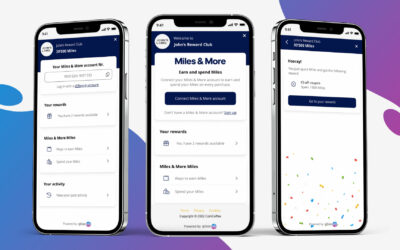Web3 & Customer Loyalty: A Framework for Web3 Loyalty Offerings
At qiibee we recognize the importance of taking a structured and strategic approach to defining a Web3-anchored loyalty offering. While many institutions have started experimenting in Web3, most of them take an opportunistic and ad hoc approach to launching initiatives. We believe that our commitment to this space must be much more tactical.
To further fortify our knowledge and development in the Web3 Loyalty space, we have carefully studied the six-pillar framework developed by Boston Consulting Group (BCG). Leading to the production of our final entry in the “Web3 & Customer Loyalty” series.
Explore the key components from BCG’s framework and how they already being utilized by some of top brands in the industry.
Web3 Loyalty Strategy & Objectives
Loyalty managers must define the overarching strategy, guardrails, priorities & objectives for their program before diving into pilots and initiatives.
Common objectives include:
-
Expanding program rewards to the wider, less active customer base
-
Expanding and streamlining partnerships
-
Attracting new customer segments
-
Boosting the frequency of customer engagement with the program or brand

Tokenization Strategy
Institutions must think through the tokenization strategy they’ll use to deploy, complement, or replace current offerings and help them execute against identified objectives.
Options fall along a spectrum of archetypes that vary by technical and regulatory complexity. Without going into too much technical detail. Four archetypes exist:
- Fungible Points: Financial institutions like SoFi and Venmo have launched crypto rewards credit cards or enabled conversion of points to crypto.
- Tangential Token Offering: Starbucks Odyssey members can earn NFTs marketed as digital collectible stamps and unlock access to new experiences.
- On-Chain Loyalty Points: The airline company Emirates leveraged Loyyal to tokenize cross-party transactions on the blockchain.
- Native Crypto Token: At the far end of the spectrum is a pure Web3 play centered around native crypto tokens that can be rewarded, bought, and traded in currency markets.

Engagement & Rewards
Beyond the traditional rewards proposition consisting of offers and benefits, companies can leverage other engagement tools that have gained traction in the Web3 world. Some use cases include:
Targeted token holder campaigns for holding exclusive NFTs, or collecting a certain number of NFTs/tokens (similar to loyalty tiers).
The use of DAO-like structures to enable the loyalty elitists or a gated subsegment of the customer base to participate in select brand decisions.
The “x-to-earn” model, where companies can gamify experiences, create hurdles and milestones across one or more partners, and reward achievements.
Token Utility
The success of any Web3 loyalty offering will entail pairing utility to issued tokens. The utility spectrum can include:
- Physical utility involving coupling access to real products & services, such as an NFT that grants access to a redeemable product.
- Social utility in the form of access to community events, VIP benefits, or exclusive brand voting rights.
- Digital utility extends privileges and access to the digital world in the form of metaverse events & virtual meetups.
An example utility with an added layer of gamification would be to implement a special event, where a customer collects three rare NFTs, which can be burned/redeemed for 1 exclusive NFT that gives them access to 1-year priority shipping.
Partner Ecosystem
A third and critical dimension to think through is to align the partner ecosystem with the brand’s loyalty partnership strategy, by using either:
- Closed networks (chains) of one-to-one or one-to-many partnerships, with fungible tokens being minted & used within that network as a form of reward or payment.
- More open ecosystem strategy is a brand issuing a tangential, collectable NFT offering and choosing a public blockchain for minting these NFTs.

Technology Partners
Navigating the Web3 technology landscape is no straightforward feat. Companies must consider several factors when navigating the Web3 technology landscape:
- What blockchain platform or loyalty solutions provider to deploy tokens on.
- Whether to use a public or private blockchain.
- Which Web3 infrastructure provider to leverage.
- What institutional wallet and custody infrastructure to select.
As we conclude this exploration of Web3 Loyalty Programs, it’s clear that the future of customer loyalty is here, and it’s more exciting than ever. By leveraging the cutting-edge capabilities of tokenization, smart contracts, and NFTs, your brand can create captivating experiences that resonate with today’s digital-savvy customers.
Set up your program for the future by embracing the Web3 revolution & transform your loyalty strategy to stay ahead of the curve. Don’t miss out on this extraordinary opportunity to elevate your brand’s loyalty program to new heights.
qiibee: Access world-class brands your customers love.
Most Recent Posts
Your Miles, Your Voice: Shape the Future of Shopping!
Make a DifferenceAre you eager to make an impact with your insights and earn up to 200 Miles in...
Breaking the Mold: Why qiibee’s Miles & More Loyalty App is Revolutionizing Shopify Loyalty Programs
In the realm of Shopify loyalty apps, the traditional approach often revolves around creating an...
Introducing qiibee: Miles & More Loyalty App for Shopify – Elevate Your Customer Loyalty Experience!
Attention Shopify Merchants! The wait is over! We are thrilled to announce the launch of the...



